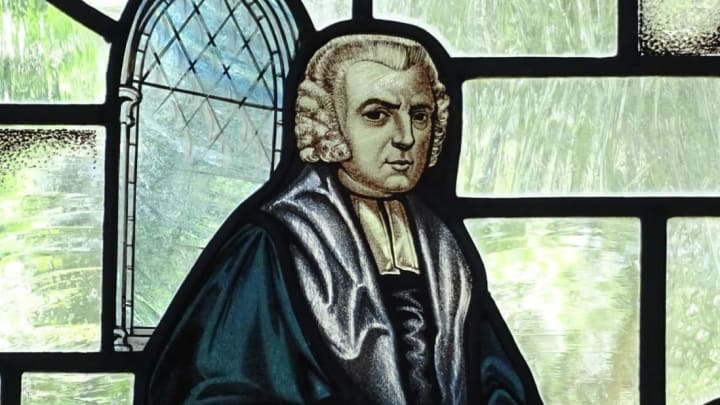Travelers driving the coast of Donegal, Ireland, may be puzzled by the road signs proclaiming, “You Are in Amazing Grace Country.” Though "Amazing Grace" is strongly linked to the United States Civil Rights movement—and achieved pop-culture prestige when Aretha Franklin recorded it on her best-selling gospel album of the same name—the song was born off the shores of Buncrana, a 6000-person town along the Wild Atlantic Way.
The History of “Amazing Grace”
“Amazing Grace” was written by John Newton, an English slave trader-turned-minister. During his early years at sea, Newton mocked religion. But a near-death experience changed his views.
While caught in a violent storm off the coast of Buncrana in 1748, Newton prayed the ship and crew would be saved. Right after a member of the crew replaced him on the deck, that man was dashed into the waves and drowned. Newton and the rest of the crew survived the storm and the harrowing journey to land. For him, their salvation sparked a spiritual awakening.
Despite his newfound faith, Newton continued to work in the slave trade. He retired for medical reasons in 1754, then studied theology and became a minister in 1764. He wrote, “I once was lost, but now am found/Was blind, but now I see,” and the rest of the stirring words that would go on to become "Amazing Grace" to accompany his sermon for New Year’s Day 1773, while pastor of an Anglican church in Olney, England. The text was later published in 1779 in Olney Hymns in Three Books, a compilation of dozens of hymns Newton wrote with poet William Cowper.
Newton’s sermon soon became popular in the newly formed U.S. It was published in New York City in 1790 and Philadelphia the next year. Many Baptist, Congregationalist, and Reformed churches used it in their hymnals by the early 1830s, but the composer of its music is unknown. A similar melody, titled “Harmony Grove,” first appeared in 1831 in a songbook called The Virginia Harmony, but it was paired with words from a different hymn. After composer William Walker tweaked the melody, renamed it “New Britain,” and paired it with Newton’s words, that version appeared for the first time in 1835 in The Southern Harmony, a popular songbook. The hymn first appeared in print with the title “Amazing Grace” in 1877’s Sacred Songs and Solos.
A Slave Trader Reforms
As the public’s perception of slavery and the slave trade shifted in Great Britain, so too did Newton’s. In 1788, four decades after the shipwreck that sparked his spiritual awakening, he penned a pamphlet entitled Thoughts Upon the African Slave Trade that was sent to all Members of Parliament [PDF]. In it, he wrote, “It will always be a subject of humiliating reflection to me, that I was, once, an active instrument in a business at which my heart now shudders.”
He continued to preach his abolitionist views. “The blood of many thousands of our helpless, much injured fellow creatures is crying against us," he stated in 1797. "The pitiable state of the survivors who are torn from their relatives, connections and their entire land must be taken into account.”
Newton greatly influenced William Wilberforce, the English lawmaker whose passionate, 20-year struggle to end slavery resulted in the 1807 law that ended the trade of enslaved people in the British West Indies. When Wilberforce was a child, Newton was his pastor, and later his mentor. The law passed the year Newton died. Because it didn’t affect the status of those enslaved before its passage, a later law in 1833, the Slavery Abolition Act, freed over 800,000 enslaved people in the British West Indies and South Africa, plus some in British Canada.
“Amazing Grace” Today
Almost 200 years after Newton wrote its lyrics, “Amazing Grace” became the ballad of the U.S. Civil Rights Movement. During the 1960s, it was sung at many Martin Luther King Jr. rallies by Mahalia Jackson.
The song remains prominent in the 21st century as well. When President Barack Obama was elected, it was sung at the Inaugural Prayer Service in 2009. Obama himself sang it during the funeral for the South Carolina state senator killed in the 2015 Charleston church shooting. A Broadway musical about the song even debuted in 2015.
Ireland’s Buncrana still celebrates its connection to the hymn. The town hosts an annual “Amazing Grace” festival, featuring music, dance, art, and historic reenactments in period dress. It's also home to Amazing Grace Park, a scenic spot overlooking the sea. The park opened in 2013, and was created with the help of the Inishowen Development Partners and the Buncrana Town Council.
There, you’ll find mosaics designed by local artist Andrew Garvey-Williams that depict Newton’s ship, The Greyhound; the words "Amazing Grace" in Newton’s handwriting; and broken chains symbolizing the end of slavery. Visitors will also spot signs quoting lines from Newton’s autobiography and other writings, which along with the mosaics, tell the surprising story behind the song.
